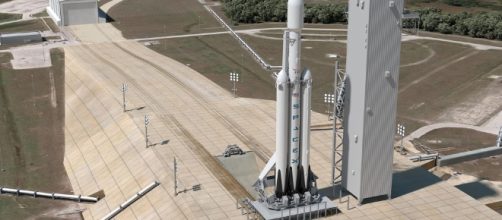As Eric Berger over at Ars Technica notes, SpaceX’s Elon Musk has set November 2017 for the first launch of the Falcon Heavy, which will be, at least for a while, the most powerful rocket since the Saturn V. On the one hand, the launch will be the most exciting event to take place on the Florida space coast since the departure of the last space shuttle in 2011. On the other hand, it will be the most anxious launch since the liftoff of the first space shuttle in 1981. As Musk suggests, there are certain things that can only be tested in flight.
What the first flight of the Falcon Heavy will tell us
The Falcon Heavy consists of a core of a modified Falcon 9 and two Falcon 9s each as strap-ons. All 27 rocket engines must ignite and work in tandem for the launch vehicle to work, also, SpaceX is uncertain how the rocket will behave when the Falcon Heavy breaks the sound barrier or when it achieves MaxQ, maximum dynamic pressure. These things can only be adequately tested in flight. Musk is expressing so much nervousness that he would consider getting the rocket off the pad without destroying it to be a victory.
What will the Falcon Heavy be used for
SpaceX has big plans for the Falcon Heavy. The launch vehicle will be able to lift heavy military payloads to geosynchronous and sun synchronous orbits.
It can also boost massive clusters of satellites all at once, such as communication satellite constellations.
However, NASA and other entities that are interested in Deep Space Exploration will be watching the first test of the Falcon Heavy with keen interest. A rocket with the power of the Falcon 9, with the first stages reusable, would be a great asset for a return to the moon or even Mars. SpaceX would like to launch a modified Dragon spacecraft with two paying customers around the moon as early as 2018. The Falcon Heavy could land payloads and even, in due time, people on the moon.
In the context of lunar exploration, the politics of the Falcon Heavy will be interesting. NASA is developing its own heavy lift rocket, the space launch system, for deep space exploration.
The SLS, in its final form, will have many times the capacity of the Falcon Heavy. However, because it is expendable, the SLS will also be many times more expensive to launch.
The obvious question will arise, if we have the Falcon Heavy, along with the Blue Origin New Glenn and New Armstrong, do we need a Space Launch System. On the one hand, it is unlikely that the government would approve the development of an SLS now with commercial heavy lift launchers drawing nigh. On the other hand, killing the NASA big rocket would be a rough political fight to undertake. The obvious conclusion is that having the Space Launch System at least gives one a certain redundancy that aerospace engineers tend to like.


